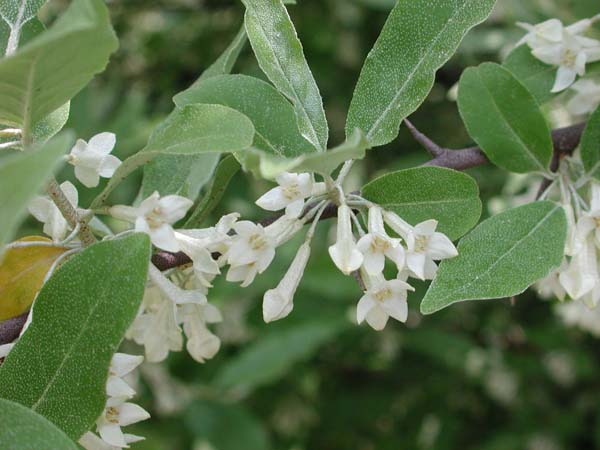Introduction
 The subject of lycopene content
in autumn-olive berries was introduced by a local property owner whose land was
covered with the invasive species Elaeagnus umbellata. Invasive
species out-compete native species
and disrupt natural ecosystems. One characteristic of autumn-olive plants
that helps them out-compete natural vegetation is their ability to adapt to poor
soil types because they have nitrogen-fixing root nodules (Fordham et al.
2001). With autumn-olive abundantly dispersed throughout his property, the
property owner sought
information about the species. He discovered that reports on the berries
showed they contain a high lycopene content (Fordham et al., 2001). He decided to pursue marketing the
berries as a food source since lycopene has recently received attention as a
beneficial substance. He harvested the berries last fall and stored
them in his freezer at -20oC. He is now attempting to market the
berries, so he contacted us to determine the actual lycopene content of his
crop currently being called "autumn berries"..
The subject of lycopene content
in autumn-olive berries was introduced by a local property owner whose land was
covered with the invasive species Elaeagnus umbellata. Invasive
species out-compete native species
and disrupt natural ecosystems. One characteristic of autumn-olive plants
that helps them out-compete natural vegetation is their ability to adapt to poor
soil types because they have nitrogen-fixing root nodules (Fordham et al.
2001). With autumn-olive abundantly dispersed throughout his property, the
property owner sought
information about the species. He discovered that reports on the berries
showed they contain a high lycopene content (Fordham et al., 2001). He decided to pursue marketing the
berries as a food source since lycopene has recently received attention as a
beneficial substance. He harvested the berries last fall and stored
them in his freezer at -20oC. He is now attempting to market the
berries, so he contacted us to determine the actual lycopene content of his
crop currently being called "autumn berries"..
Lycopene is a potent antioxidant
found in watermelon, tomato, and red grapefruit and may exert numerous
positive effects on human health (Fish et al. 2002). The effect of
lycopeneís strong antioxidant properties may also help in regulating cholesterol
metabolism (Sesso et al. 2003). This may minimize the effects of
cholesterol on the heart muscle. The effects of lycopene are also noticed in
the eyes of people and the effect they have on cataracts because it offers
protection to the lens (Mohanty et al. 2002). Most of these studies
where based on tomatoes and havenít considered other fruits that have high
amounts of lycopene. However, lycopene still remains the most important
carotenoid in the diet of North Americans (Tawfak, 2002). Autumn berries may
offer people an alternative dietary form of lycopene.
We conducted an
experiment to see if the local autumn berries do in fact contain high amounts of
lycopene. This was done by comparing autumn berries to other fruits known for
their lycopene content.
 The subject of lycopene content
in autumn-olive berries was introduced by a local property owner whose land was
covered with the invasive species Elaeagnus umbellata. Invasive
species out-compete native species
and disrupt natural ecosystems. One characteristic of autumn-olive plants
that helps them out-compete natural vegetation is their ability to adapt to poor
soil types because they have nitrogen-fixing root nodules (Fordham et al.
2001). With autumn-olive abundantly dispersed throughout his property, the
property owner sought
information about the species. He discovered that reports on the berries
showed they contain a high lycopene content (Fordham et al., 2001). He decided to pursue marketing the
berries as a food source since lycopene has recently received attention as a
beneficial substance. He harvested the berries last fall and stored
them in his freezer at -20oC. He is now attempting to market the
berries, so he contacted us to determine the actual lycopene content of his
crop currently being called "autumn berries"..
The subject of lycopene content
in autumn-olive berries was introduced by a local property owner whose land was
covered with the invasive species Elaeagnus umbellata. Invasive
species out-compete native species
and disrupt natural ecosystems. One characteristic of autumn-olive plants
that helps them out-compete natural vegetation is their ability to adapt to poor
soil types because they have nitrogen-fixing root nodules (Fordham et al.
2001). With autumn-olive abundantly dispersed throughout his property, the
property owner sought
information about the species. He discovered that reports on the berries
showed they contain a high lycopene content (Fordham et al., 2001). He decided to pursue marketing the
berries as a food source since lycopene has recently received attention as a
beneficial substance. He harvested the berries last fall and stored
them in his freezer at -20oC. He is now attempting to market the
berries, so he contacted us to determine the actual lycopene content of his
crop currently being called "autumn berries"..